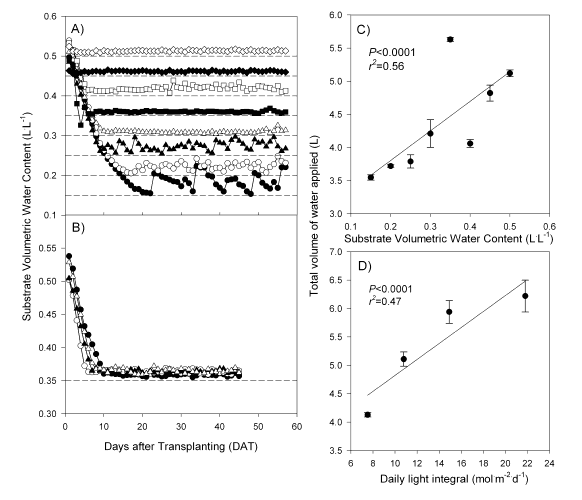Research Highlights: Crop-Specific Water Requirements and Preserving Water Resources
By Katherine Garland, Extension Horticulturist
According to the US Department of Agriculture, greenhouse and nursery sales ranked fourth among agricultural commodities in Maine and seventh in the nation in 2008. Greenhouse and nursery plant production relies on a supply of clean water for irrigation and often uses supplemental lighting to enhance the quality and growth of plants. Increasing energy costs and more frequent water shortages associated with changing demographics, water use legislation, and climate factors have inspired growers to consider more sustainable approaches to using water and energy. Precise, crop-specific water and light recommendations are essential to help growers make more sustainable production decisions.
Two investigations were conducted to determine the water and light requirements for Heuchera americana ‘Dale’s Strain’ (Heuchera), an herbaceous perennial prized for its variegated foliage. We grew plants using a unique irrigation system that maintains constant substrate moisture levels using moisture sensors. In this system, an irrigation controller triggers a solenoid valve to open for a very short period of time if the sensors indicate that the moisture content is low.
In the first study, the substrate was maintained at a range of moisture levels while the second experiment assessed performance under constant moisture conditions but different light levels.
Total leaf area in plants grown at the highest moisture content was more than twice that observed in plants grown at the lowest moisture content. Shoot dry weight also responded positively to increasing moisture, but only up to a point. DLI caused dry weight, leaf area, maximum width, and leaf count to increase, also only to an apparent saturation point, beyond which leaf area, leaf width, and leaf count decreased.
Measures of fluorescence, net photosynthesis, light response curves, and carbon dioxide response curves indicated no physiological differences among plants grown under different water or light treatments. Water use efficiency based on dry weight and water applied decreased with increasing moisture and light, while water use efficiency based on leaf gas exchange was not influenced by moisture and increased with increasing light. From this information, we can provide growers with recommended moisture and light conditions for optimal heuchera production.
One particular item to note in both studies is the minimal amount of water applied over the entire production period. Our findings showed that only five liters of water are required to grow a marketable heuchera over a period of eight weeks. Irrigation systems based on substrate moisture status, a relatively new technology, have already saved commercial growers tens of thousands of dollars on energy and water expenses (not including labor costs). With more precise information on crop water requirements, we hope that more growers will consider using this technology to reduce reliance on limited energy and water resources.

